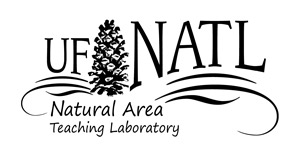| UF Academic Use | Public Use | Family Fun and K-12 Education |

Trail guide history and archive
As each of the three upland nature trails was developed, T. J. Walker prepared a three-page advanced trail guide for it and stocked copies of the appropriate guide in a document box attached to each trailhead kiosk. Each guide described what maight be learned along its trail at 25 points-of-interest marked with numbered stakes. Changes in what was conspicuous and/or interesting along each trail were accommodated by monthly or bimonthly changes in the content of the trail guides and in the positions of the stakes along the trail. In the table below are links to the MS Word files of most of these advanced trail guides.
| Upland Pine | Old-Field | Hammock | |
| 2006 | September, October, November, December, |
November, December | |
| 2007 | January, February, March, April, May, June, July, August, September, October, November, December | January, February, March, April, May, June, July, August, September, October, November, December | March, April, May, June, July, August, September, October, November, December |
| 2008 | January, February, March, April, May, June, July, September, October, December | January, February, March, April, May, June, July, September, October, December | January, February, March, April, May, June, July, September, October, December |
| 2009 | February, April | February, April | February, April |
In 2007 and early 2008, to explain the upland trails to those who lacked the time or interest to use the advanced trail guides, T.J. Walker prepared basic trail guides, printed on one side of an 8.5x11-inch sheet. These described some of the most important features of the trails and were made available at each trailhead kiosk in a second document box. The content of the basic guides were keyed to eight stakes lettered A to H along each trail. These are the initial basic guides: Upland Pine, Old Field, Hammock.
In the fall of 2008, NATL teaching assistants were given the task of improving the basic guides. By January 2009, Erica Van Etten and Bret Pasch had updated, reformatted, and illustrated the three guides (Upland Pine, Old Field, Hammock). Until Bret Pasch, in spring of 2009, prepared a basic guide for the SEEP trail, SEEP trail interpretaion had been limited to displays at kiosks and on 3x2ft signs along the trail. In 2010, the SEEP basic guide was dropped in favor of distributing interpretive information along the trail in the form of 5x4-inch photosigns.
In 2009, starting with the Upland Pine Nature Trail, T.J. Walker initiated a program to eliminate both the advanced and basic guides for the upland nature trails. The concept was to present the content of the printed guides (and more) by installing a sequence of signs along the trails. The signs are of four types: 11x8.5-inch "text signs" and three sizes of "photosigns" (signs that incorporate color photos related to the subjects of the signs). The text signs are used for directional signs and for verbal content of the sorts that had been in the printed guides. For example, here are the Upland Pine text signs as of Feb. 2011. For those who want to learn more about a trail's ecosystem than is presented by the distributed signs, an academic guide is available in a document box on the trailhead kiosk. Here is the current Upland Pine academic guide.


